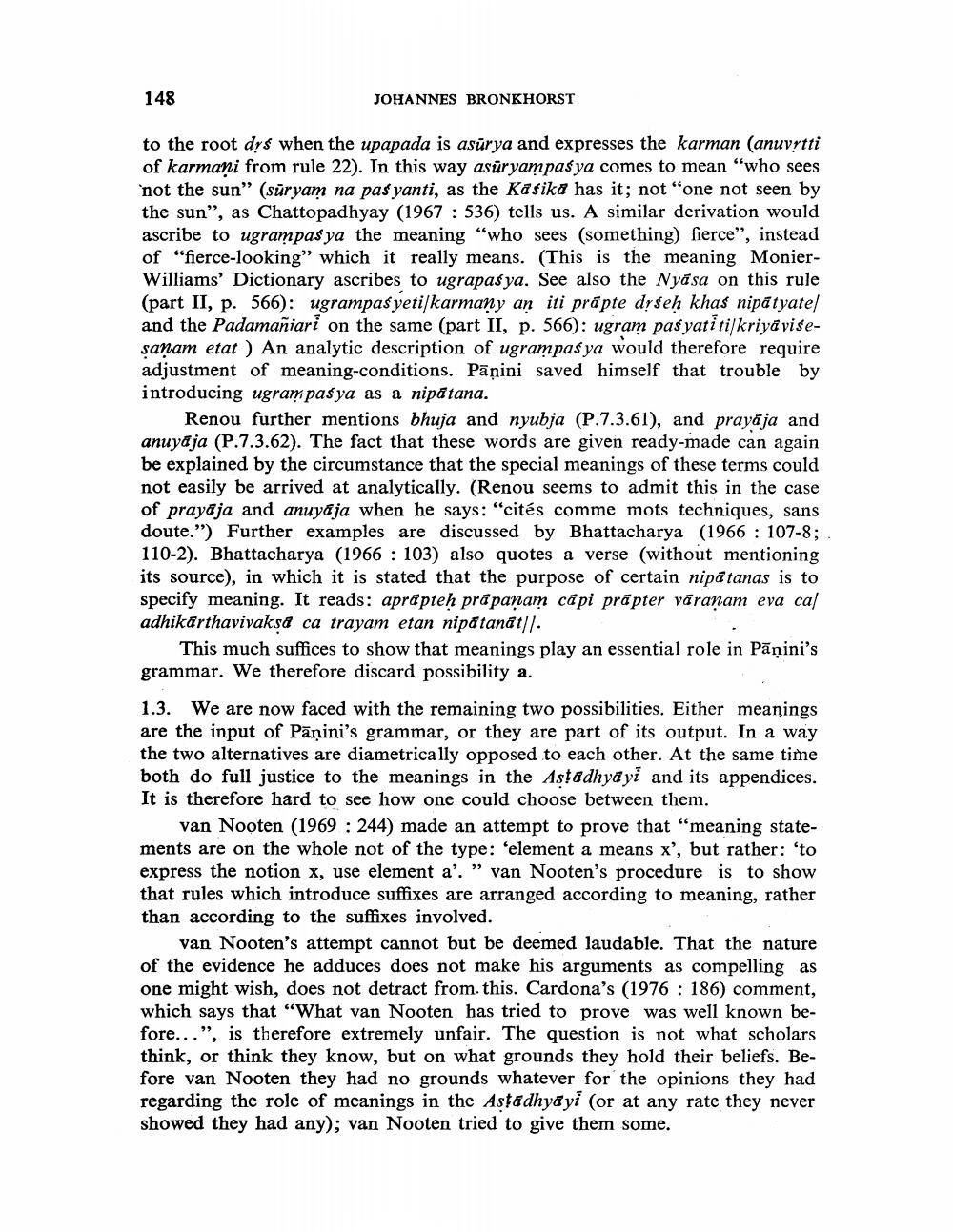________________
148
JOHANNES BRONKHORST
to the root dys when the upapada is asurya and expresses the karman (anuvytti of karmani from rule 22). In this way asüryampas ya comes to mean "who sees ‘not the sun" (sūryam na pasyanti, as the Kasika has it; not "one not seen by the sun", as Chattopadhyay (1967 : 536) tells us. A similar derivation would ascribe to ugrampas ya the meaning "who sees (something) fierce", instead of "fierce-looking" which it really means. (This is the meaning MonierWilliams' Dictionary ascribes to ugrapasya. See also the Nyāsa on this rule (part II, p. 566): ugrampas yeti/karmany an iti prapte dyseh khas nipătyatel and the Padamañiari on the same (part II, p. 566): ugram pas yati ti/kriyāvisesaņam etat ) An analytic description of ugrampas ya would therefore require adjustment of meaning-conditions. Pāṇini saved himself that trouble by introducing ugrampasya as a nipa tana.
Renou further mentions bhuja and nyubja (P.7.3.61), and prayāja and anuyä ja (P.7.3.62). The fact that these words are given ready-made can again be explained by the circumstance that the special meanings of these terms could not easily be arrived at analytically. (Renou seems to admit this in the case of prayaja and anuyaja when he says: "cités comme mots techniques, sans doute.") Further examples are discussed by Bhattacharya (1966 : 107-8; 110-2). Bhattacharya (1966 : 103) also quotes a verse (without mentioning its source), in which it is stated that the purpose of certain nipa tanas is to specify meaning. It reads: aprapteh prápanam câpi prāpter võranam eva cal adhikarthavivaksd ca trayam etan nipa tanat)l.
This much suffices to show that meanings play an essential role in Pāṇini's grammar. We therefore discard possibility a.
1.3. We are now faced with the remaining two possibilities. Either meanings are the input of Pāṇini's grammar, or they are part of its output. In a way the two alternatives are diametrically opposed to each other. At the same time both do full justice to the meanings in the Astadhyayi and its appendices. It is therefore hard to see how one could choose between them.
van Nooten (1969 : 244) made an attempt to prove that “meaning statements are on the whole not of the type: 'element a means x', but rather: 'to express the notion x, use element a'. " van Nooten's procedure is to show that rules which introduce suffixes are arranged according to meaning, rather than according to the suffixes involved.
van Nooten's attempt cannot but be deemed laudable. That the nature of the evidence he adduces does not make his arguments as compelling as one might wish, does not detract from this. Cardona's (1976: 186) comment, which says that "What van Nooten has tried to prove was well known before...", is therefore extremely unfair. The question is not what scholars think, or think they know, but on what grounds they hold their beliefs. Before van Nooten they had no grounds whatever for the opinions they had regarding the role of meanings in the Astadhyayi (or at any rate they never showed they had any); van Nooten tried to give them some.




